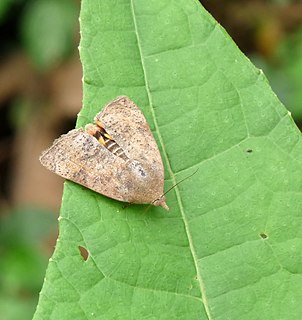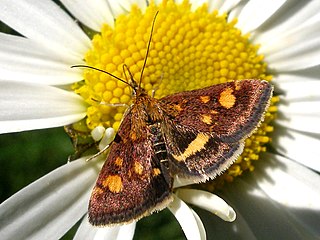Related Research Articles

The Pyralidae, commonly called pyralid moths, snout moths or grass moths, are a family of Lepidoptera in the ditrysian superfamily Pyraloidea. In many classifications, the grass moths (Crambidae) are included in the Pyralidae as a subfamily, making the combined group one of the largest families in the Lepidoptera. The latest review by Eugene G. Munroe and Maria Alma Solis, in Kristensen (1999) retains the Crambidae as a full family of Pyraloidea.

The Pyraloidea are a moth superfamily containing about 16,000 described species worldwide, and probably at least as many more remain to be described. They are generally fairly small moths, and as such, they have been traditionally associated with the paraphyletic Microlepidoptera.

Hyblaeidae are the "teak moths", a family of insects in the Lepidopteran order. The two genera with about 18 species make up one of the two families of the Hyblaeoidea superfamily, which in the past has been included in the Pyraloidea. Recent phylogenetic studies find varying relationships of Hyblaeoidea among Ditrysian Lepidoptera: Mutanen et al. (2010) find the superfamily to group either with Pyraloidea, or – more often – with Thyridoidea or butterflies. The results of Wahlberg et al. (2013) and Heikilä et al. (2015) indicate a sister-group relationship with Pyraloidea.

Spilomelinae is a very species-rich subfamily of the lepidopteran family Crambidae, the crambid snout moths. With 4,132 described species in 340 genera worldwide, it is the most speciose group among pyraloids.
In biological taxonomy, circumscription is the content of a taxon, that is, the delimitation of which subordinate taxa are parts of that taxon. If we determine that species X, Y, and Z belong in Genus A, and species T, U, V, and W belong in Genus B, those are our circumscriptions of those two genera. Another systematist might determine that T, U, V, W, X, Y, and Z all belong in genus A. Agreement on circumscriptions is not governed by the Codes of Zoological or Botanical Nomenclature, and must be reached by scientific consensus.

Eudonia is a large and widespread genus in the grass moth family (Crambidae), subfamily Scopariinae. There is no common name for the roughly 250 species placed here; new species are still being described regularly. Although the genus was proposed early in the 19th century already, many of these moths were for a long time retained in Scoparia, the type genus of the subfamily and a close relative of Eudonia. A few small genera have been proposed for separation from Eudonia, but given the size of this group this is not particularly convincing; thus, all are retained here pending a comprehensive phylogenetic review.

Pyralis regalis is a species of snout moth. It is found from most of Europe east to Asia, including China, Cambodia, Myanmar, India, Russia, Korea, Japan and Taiwan.

The Phycitini are a tribe of moths of the family Pyralidae.
The Anerastiini are a tribe of moths of the family Pyralidae.

Phycitodes albatella is a species of snout moth. It is found in most of Europe, Uzbekistan and North America.
Phycitodes inquinatella is a species of snout moth. It is found in most of Europe, the Canary Islands, Turkey and the Palestinian Territories.
Scoparia ingratella is a species of moth in the family Crambidae. It is found in most of Europe, except Ireland, Great Britain, the Benelux, Portugal, Fennoscandia, the Baltic region and Ukraine.
Scoparia manifestella is a species of moth in the family Crambidae. It is found in France, Italy, Austria, Switzerland, Germany and on the Balkan Peninsula.

Pyrausta falcatalis is a species of moth in the family Crambidae. It is found in France, Germany, Austria, Switzerland, Italy, the Czech Republic, Poland, Slovenia, Hungary, Bosnia and Herzegovina, the Republic of Macedonia, Romania, Bulgaria, Moldova, Ukraine, Russia and Turkey. It has also been recorded from China.
Pyrausta obfuscata is a species of moth in the family Crambidae. It is found from Spain to Belgium and from France to the Balkan Peninsula, Ukraine and Russia.
Pyrausta virginalis is a species of moth in the family Crambidae. It is found in southern Europe, Turkey, Armenia and Afghanistan.

Platytes cerussella is a species of moth in the family Crambidae. It is found in almost all of Europe.
Glaphyriinae is a subfamily of the lepidopteran family Crambidae. It was described by William Trowbridge Merrifield Forbes in 1923

Scopariinae is a subfamily of the lepidopteran family Crambidae. The subfamily was described by Achille Guenée in 1854.
Zebronia phenice is a moth in the family Crambidae. It was described by Stoll in 1782. It is found in Cameroon, Mayotte, the Democratic Republic of Congo, Equatorial Guinea, Ethiopia, Gabon, Ghana, Ivory Coast, Kenya, La Réunion, Madagascar, Mauritius, Mozambique, Nigeria, Senegal, Sierra Leone, South Africa, Tanzania, Gambia, Uganda, Zambia and Zimbabwe.
References
- ↑ "global Pyraloidea database". Globiz.pyraloidea.org. Retrieved 2014-07-15.
- ↑ Pyralidae of the Third Archbold Expedition. 1. Subfamily Odontiinae (Lepidoptera)
| This Odontiinae-related article is a stub. You can help Wikipedia by expanding it. |